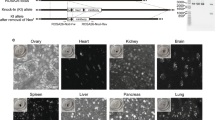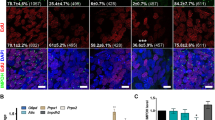Abstract
Human TSPY is a candidate oncogene and is supposed to function as a proliferation factor during spermatogenesis. It is the only mammalian protein-coding gene known to be organized as a tandem repeat gene family. It is expressed at highest level in spermatogonia and to a lower amount in primary spermatocytes. To characterize the human TSPY promoter we used the luciferase reporter system in a mouse spermatogonia derived cell line (GC-1spg) and in a GC-4spc cell line, that harbour prophase spermatocytes of the preleptotene and early pachytene stage. We isolated a 1303 bp fragment of the 5′-flanking region of exon 1 that shows significant promoter activity in GC-1spg and reduced activity in GC-4spc cells. In order to gain further insight into the organization of the TSPY-promoter, stepwise truncations of the putative promoter sequence were performed. The resulting fragments were cloned into the pGL3-vector and analysed for reporter gene activity in the murine germ cell lines GC-1spg and GC-4spc, leading to the characterization of a core promoter (−159 to −1), an enhancing region (−673 to −364) and a silencing region (−1262 to −669). Database research for cis-active elements yielded two putative SOX-like binding sites in the enhancing region and reporter gene activity was drastically reduced when three nucleotides of the AACAAT SOX core sequence were mutated. Our findings strongly suggest that testis-specific expression of human TSPY is mediated by Sox proteins. (Mol Cell Biochem 276: 159–167, 2005)
Similar content being viewed by others
References
Arnemann J, Epplen JT, Cooke HJ, Sauermann U, Engel W, Schmidtke J: A human Y-chromosomal DNA sequence expressed in testicular tissue. Nucleic Acids Res 15: 8713–8724, 1987
Manz E, Schnieders F, Müller Brechlin A, Schmidtke J: TSPY-related sequences represent a microheterogenous gene family organized as constitutive elements in DYZ5 tandem repeat units on the human Y chromosome. Genomics 17: 726–731, 1993
Dechend F, Williams G, Skawran B, Schubert S, Krawczak M, Tyler-Smith C, Schmidtke J: TSPY variants in six loci on the human Y chromosome. Cytogenet Cell Genet 91: 67–71, 2000
Vogel T, Schmidtke J: Structure and function of TSPY, the Y-chromosome gene coding for the “testis-specific protein”. Cytogenet Cell Genet 80: 209–213, 1998
Schnieders F, Dörk T, Arnemann J, Vogel T, Werner M, Schmidtke J: Testis-specific protein, Y-encoded (TSPY) expression in testicular tissues. Hum Mol Genet 5: 1801–1807, 1996
Vogel T, Dechend F, Manz E, Jung C, Jakubiczka S, Fehr S, Schmidtke J: Organization and expression of bovine TSPY. Mamm Genome 8: 491–496, 1997
Vogel T, Dittrich O, Mehraein Y, Dechend F, Schnieders F, Schmidtke J: Murine and human TSPYL genes: Novel members of the TSPY-SET-NAP1L1 family. Cytogenet Cell Genet 81: 265–270, 1998
Chai Z, Sarcevic B, Mawson A, Toh BH: SET-related cell division autoantigen-1 (CDA1) arrests cell growth. J Biol Chem 276: 33665–33674, 2001
Ozbun LL, You L, Kiang S, Angdisen J, Martinez A, Jakowlew SB: Identification of differentially expressed nucleolar TGF-beta 1 target (DENTT) in human lung cancer cells that is a new member of the TSPY/SET/NAP-1 superfamily. Genomics 73: 179–193, 2001
Delbridge ML, Longepied G, Depetris D, Mattei MG, Disteche CM, Graves JAM, Mitchell MJ: TSPY, the candidate gonadoblastoma gene on the human Y chromosome has a widely expressed homologue on the X-implications for Y chromosome evolution. Chromosome Res 12: 345–356, 2004
Lau Y, Chou P, Iezzoni J, Alonzo J, Komuves L: Expression of a candidate gene for the gonadoblastoma locus in gonadoblastoma and testicular seminoma. Cytogenet Cell Genet 91: 160–164, 2000
Hildenbrand R, Schroder W, Brude E, Schepler A, Konig R, Stutte HJ, Arnemann J: Detection of TSPY protein in a unilateral microscopic gonadoblastoma of a Turner mosaic patient with a Y-derived marker chromosome. J Pathol 189: 623–626, 1999
Tsuchiya K, Reijo R, Page DC, Disteche CM: Gonadoblastoma: Molecular definition of the susceptibility region on the Y chromosome. Am J Hum Genet 57: 1400–1407, 1995
Schubert S, Skawran B, Dechend F, Nayernia K, Meinhardt A, Nanda I, Schmid M, Engel W, Schmidtke J: Generation and characterization of a transgenic mouse with a functional human TSPY. Biol Reprod 69: 968–975, 2003
Tascou S, Nayernia K, Samani A, Schmidtke J, Vogel T, Engel W, Burfeind P: Immortalization of murine male germ cells at a dicrete stage of differentiation by a novel directed promotor-based selection strategy. Biol Reprod 63: 1555–1561, 2000
Firzlaff JM, Luscher B, Eisenman RN: Negative charge at the casein kinase II phosphorylation site is important for transformation but not for Rb protein binding by the E7 protein of human papillomavirus type 16. Proc Natl Acad Sci U S A 88: 5187–5191, 1991
Bousset K, Oelgeschlager MH, Henriksson M, Schreek S, Burkhardt H, Litchfield DW, Luscher-Firzlaff JM, Luscher B: Regulation of transcription factors c-Myc, Max, and c-Myb by casein kinase II. Cell Mol Biol Res 40: 501–511, 1994
Wegener M: From head to toes: The multiple facets of Sox proteins. Nucleic Acids Res 27: 1409–1420, 1998
Ratti A, Stuppia L, Gatta V, Fogh I, Calabrese G, Pizzuti A, Palka G: Characterization of a new TSPY gene family member in Yq (TSPYq1). Cytogenet Cell Genet 88: 159–162, 2000
Romier C, Cocchiarella F, Mantovani R, Moras D: The NF-YB/NF-YC structure gives insight into DNA binding and transcription regulation by CCAAT factor NF-Y. J Biol Chem 278: 1336–1345, 2003
Rauscher FJ, Morris JF, Tournay OE, Cook DM, Curran T: Binding of the Wilms’ tumor locus zinc finger protein to the EGR-1 consensus sequence. Science 250: 1259–1262, 1990
Hossain A, Saunders GF: The human sex-determining gene SRY is a direct target of WT1. J Biol Chem 276: 16817–16823, 2001
Kanai Y, Kanai-Azuma M, Noce T, Saido TC, Shiroishi T, Hayashi T, Yazaki K: Identification of two Sox17 messenger RNA isoforms, with and without the high mobility group box region, and their differential expression in mouse spermatogenesis. J Cell Biol 133: 667–681, 1996
Osaki E, Nishina Y, Inazawa J, Copeland NG, Gilbert DJ, Jenkins NA, Ohsugi M, Tezuka T, Yoshida M, Semba K: Identification of a novel Sry-related gene and its germ cell-specific expression. Nucleic Acids Res 27: 2503–2510, 1999
Reddy JC, Licht JD: The WT1 Wilms’ tumor suppressor gene: How much do we really know? Biochim Biophys Acta 1287: 1–28, 1996
Nachtigal MW, HirokawaY, Enyeart-Vanhouten DL, Flanagan JN, Hammer GD, Ingraham HA: Wilms’ tumor 1 and Dax-1 modulate the orphan nuclear receptor SF-1 in sex-specific gene expression. Cell 93: 445–454, 1998
Lee SB, Huang K, Palmer R, Truong VB, Herzlinger D, Kolquist KA, Wong J, Paulding C, Yoon SK, Gerald W, Olingern JD, Haber DA: The Wilms tumor suppressor WT1 encodes a transcriptional activator of amphiregulin. Cell 98: 663–673, 1999
Hosono S, Gross I, English MA, Hajra KM, Fearon ER, Licht JD: E-cadherin is a WT1 target gene. J Biol Chem 275: 10943–10953, 2000
Wagner KJ, Roberts SG: Transcriptional regulation by the Wilms’tumour suppressor protein WT1. Biochem Soc Trans 32: 932–935, 2004
Watanabe D, Okabe M, Hamajima N, Morita T, Nishina Y, Nishimune Y: Characterization of the testis-specific gene calmegin promoter sequence and its activity defined by transgenic mouse experiments. FEBS Lett 368: 509–512, 1995
Tascou S, Trappe R, Nayernia K, Jarry H, König F, Schulz-Schaeffer W, Saeger W, Meinhardt A, Engel W, Schmidtke J, Burfeind P: TSPY-LTA transgenic mice develop endocrine tumors of the pituitary and adrenal gland. Mol Cell Endocrinol 28: 9–18, 2003
Domenjoud L, Nussbaum G, Adham IM, Greeske G, Engel W: Genomic sequences of human protamines whose genes, PRM1 and PRM2, are clustered. Genomics 8: 127–133, 1990
Burkhardt E, Adham IM, Brosig B, Gastmann A, Mattei MG, Engel W: Structural organization of the porcine and human genes coding for a Leydig cell-specific insulin-like peptide (LEY I-L) and chromosomal localization of the human gene (INSL3). Genomics 20: 13–19, 1994
Wolfe SA, van Wert JM, Grimes SR: Expression of the testis-specific histone H1t gene: evidence for involvement of multiple cis-acting promoter elements. Biochemistry 34: 12461–12469, 1995
Blake MC, Jambou RC, Swick AG, Kahn JW, Azizkhan JC: Transcriptional initiation is controlled by upstream GC-box interactions in a TATAA-less promoter. Mol Cell Biol 10: 6632–6641, 1990
Virbasius JV, Scarpulla RC: The rat cytochrome c oxidase subunit IV gene family: Tissue-specific and hormonal differences in subunit IV and cytochrome c mRNA expression. Nucleic Acids Res 25: 6581–6586, 1990
Lu J, Lee W, Jiang C, Keller EB: Start site selection by Sp1 in the TATA-less human Ha-ras promoter. J Biol Chem 18: 5391–5402, 1994
Mantovani R: A survey of 178 NF-Y binding CCAAT boxes. Nucleic Acids Res 26: 1135–1143, 1998
Müller C, Yang R, Beck-von-Peccoz L, Idos G, Verbeek W, Koeffler HP: Cloning of the cyclin A1 genomic structure and characterization of the promoter region. GC boxes are essential for cell cycle-regulated transcription of the cyclin A1 gene. J Biol Chem 16: 11220–11228, 1999
Author information
Authors and Affiliations
Corresponding author
Rights and permissions
About this article
Cite this article
Skawran, B., Schubert, S., Dechend, F. et al. Characterization of a human TSPY promoter. Mol Cell Biochem 276, 159–167 (2005). https://doi.org/10.1007/s11010-005-3801-x
Received:
Accepted:
Issue Date:
DOI: https://doi.org/10.1007/s11010-005-3801-x




